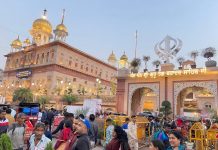
By Rishpal Singh Sidhu | Opinion |
It is not an uncommon occurrence to see a sewadar or a member of the sangat (congregation) gently reminding visitors to a gurdwara to please cover their heads when entering the Darbar Sahib or Diwan Hall where the Guru Granth Sahib is kept on a Manji Sahib under a canopy (Chanani or Palki) when Sikh prayer is in progress or when it is covered with a cloth when it is not being read. While covering their heads has never really been an issue with amritdhari Sikhs, it applies to Mona Sikhs (clean shaven) and other visitors to a gurdwara who are expected to wear a patka, scarf, or other head covering. This article seeks to examine and explore the historical origins and reasons behind this long established custom of covering the head, the propounded reasons and benefits of doing so, and whether it is also practiced by followers of other religious faiths.
While there appear to be no references to a turban or head-covering in the Guru Granth Sahib, the Sikh Rehat Maryada (The Code of Sikh Conduct & Conventions) Section 4, Chapter X, Article XVI (t) states that “for a Sikh, there is no restriction or requirement as to dress except that he must wear Kachhehra (a drawer type undergarment fastened by a fitted string round the waist, very often worn as an underwear) and turban. A Sikh woman may or may not tie a turban”. Interestingly, Chapter X, Article XVI (s) makes it perfectly clear that “it is not proper for a Sikh woman to wear veil or keep her face hidden by veil or cover”. Recent years have also witnessed a noticeable trend of Sikh females in Britain and Canada wearing turbans, although Guru Gobind Singh did not proscribe this practice when he institutionalized the Sikh identity through the establishment of the Khalsa tradition in 1699 with the keeping of kesh (uncut hair) as one of the Five Ks of the Khalsa .
It is not really known what Guru Nanak looked like and what clothes he wore. However, some narratives and ubiquitous images appear to suggest that he wore a saffron robe, his shoulders were draped in a brown shawl, he had a white beard, and that he wore a turban in the simple Dumalla style (“Du” meaning two and “Malla” meaning cloth or fabric). According to some historical accounts, Guru Nanak bestowed Guru Angad with a special dastar when he was declared the next Guru, and Guru Arjan was likewise honored on the passing of Guru Ram Das. There are also references in Sikh history describing how Guru Gobind Singh personally tied dumallas on the heads of his older sons, Ajit Singh and Jujar Singh. In Gurbilas patshahi 10, a poetic account of Guru Gobind Singh’s life completed by Kuir Singh in 1751, forty three years after Guru Gobind Singh’s death, it is recounted that in introducing the Panj Pyare, Guru Gobind Singh and the five disciples allwore saffron colored rainment topped over with neatly tied turbans of the same color.1
The origins of the turban date back to ancient India and to Mesopotamian times where there is some evidence of a turban-like headwear in a royal sculpture from 2350 B.C.E. It is fairly clear that the turban was in use long before the advent of Islam and Christianity and its early origins had little to do with religious practices. It is only in recent times that covering the head during worship has taken on different meanings and different uses in different religions. The practice of wearing head covers and veils for religious purposes has, at some time or other, also been an integral part of three monotheistic religions, namely Christianity, Judaism, and Islam.
In the early years of Christianity, both men and women were supposed to cover their heads when entering their place of worship. In the Church of England Book of common prayer and administration 1706 it is written that “no man shall cover his head in the church or chapel in the time of divine service”. Saint Paul, Apostle of the Gentiles, amended this tradition and that only women were supposed to cover their heads at their place of worship. In the New International Version (NIV) of the Bible in 1 Corinthians 11:5, it is written that “every woman who prays or prophesies with her head uncovered, dishonors her head, for that is one and the same as if her head were shaved.” This practice of Christian head covering for praying and prophesying is also prescribed in the traditional interpretation of 1 Corinthians 11:2-6 in the New Testament of the Bible.”2 Early Christian women veiled their heads not only in church but also at any time they were in public. Head covering during prayer continues to be a common practice in many parts of the world such as Romania, Russia, Ukraine, Ethiopia, India, Pakistan, and South Korea, and variations exist in the style of head covering in these regions. At the beginning of the 20th century in Western Europe and North America, women in some mainstream Christian denominations wore head coverings during church services. Over the years, this practice has evolved from the wearing of veils and caps to the wearing of hats, scarfs, and ornate bonnets which have become more a fashion statement rather than modesty and reverence to the Divine. Today, only a few people can be observed covering their heads inside a church. In this context, theologian and religious broadcaster the late Dr. R.C. Sproul opined that “our biblical views of women were gradually eroded by the modern feminist movement that has infiltrated the Church”. The Head Covering Movement is a community of Christians who are sparking a return to the biblical practice of head covering.
Islam requires both men and women to dress appropriately when visiting the mosque. Women are expected to cover their head and most of their body by wearing long and full sleeve clothing, The menfolk are also required to dress appropriately and to cover their heads with a round white cap called a taqiyah in keeping with instructions in the Koran. Head covering also plays an important role for both genders among the Hasidic Jews.
In Hindu temples both, women and men, cover their heads as a mark of respect, gratitude, and humility towards God. This rule is not too strictly enforced in Northern Indian temples as compared to some South Indian temples some of which have really strict rules that include a dress code before entering the temple.
In Sikhism, as part of protocol when entering the gurdwara, one is expected to remove one’s shoes and cover one’s head as signs of respect towards the sovereignty of the Guru Granth Sahib. Furthermore, some gurdwaras require that hands and feet are also washed, and socks removed on entering the Darbar Sahib. Does the covering of one’s head only apply in the gurdwara in the presence of the Guru Granth Sahib or even when travelling on the train or at home when listening to and/or reading digital or print copies of gutkas containing Nitnem Banis, Sukhmani Sahib, and Asa Ki Var? Indeed, it does. It is indeed true that covering the head gives some degree of protection from dirt and dust, heat and cold, and other inclemencies of the weather. Some writers have suggested that, besides respect, covering the heads also protects the unseen metaphoric dasam duar or tenth door which is at the top of the head, which remains closed, and which needs to be opened for deep spiritual experience. The nine doors (nau darvaje) and the tenth door are frequently mentioned together to show their differences. The unstruck sound is heard at the tenth door when it is freed from the shackles of nine doors in the body.
ਨਉ ਦਰਵਾਜੇ ਦਸਵੈ ਮੁਕਤਾ ਅਨਹਦ ਸਬਦੁ ਵਜਾਵਣਿਆ ॥੩॥ (SGGS, ang.110)
Beyond the nine gates, the Tenth Gate is found, and liberation is obtained. The Unstruck Melody of the Shabad vibrates. ||3||
In Sikh theology, “the tenth door is the supreme state of the mind. It is that state of purified consciousness in which God is visible and all contacts with physical existence are cut off. The Invisible and Infinite dwells at the tenth house or tenth door. The nectar like essence (amrit ras) is dripped by the Satguru; it comes out appearing at the tenth door. The sounding of the unstruck sound announces, as it were, the manifestation of God at this door.”3 In the Sikh religious literature the seeker of the truth is urged to open this door to realize enlightenment.
ਦਸਵੈ ਵਾਸਾ ਅਲਖ ਅਪਾਰੈ (SGGS, ang. 1036)
ਤਹ ਅਨਹਦ ਸਬਦ ਵਜਹਿ ਧੁਨਿ ਬਾਣੀ ਸਹਜੇ ਸਹਜਿ ਸਮਾਈ ਹੇ ॥੬॥ (SGGS, ang. 1069)
This begs the wider question on whether covering one’s head while worshipping is just a matter of respect and etiquette or are there more deep seated reasons for this practice? Besides housing the thinking brain, there are some who believe that the crown chakra at the center of our head is the focal point of storing energy in our bodies and that if the head is not covered then the positive energy acquired by them in prayer will be lost through the head. The contrary and possibly unproven proposition is that most of the body’s energy escapes and is lost if our heads are not covered. In the Punjab among Sikhs and Hindus, head covering is sometimes also done as a mark of respect to our superiors or elders, be they relations or father figures.
The covering of one’s head in prayer has been a sign of respect across many cultures, including Sikhism and the wearing of our turbans serves as a prominent mark of our Sikh identity. More importantly, it is our state of mind in prayer that matters more, for it has been rightly said that besides such external manifestations, be they dastars, chunnis, dupattas, patkas, or scarfs, genuine prayer comes from the heart where the Divine resides.
REFERENCES
1. Singh, Kuir. Gurbilas Patshahi 10. First published in 1968. Edited by Shamsher Singh Ashok and published in 1999 by Punjabi University Patiala.
2. Osburn, Carroll D. (1 July 2007). Essays on women in earliest Christianity, vol. 1, Wipf and Stock Publishers, p.208.
3. Singh, Harbans. (1995). Editor-in-Chief. The encyclopaedia of Sikhism. Punjabi University, Patiala. pp.513-514.

Rishpal Singh Sidhu has been involved in library and information services management in Singapore, New Zealand, and Australia over the past four decades. He has a passion for research, writing, and teaching. He is the compiler and editor of the book, Singapore’s early Sikh pioneers: Origins, settlement, contributions and Institutions, published by the Central Sikh Gurdwara Board in Singapore in 2017. He is presently based in Sydney, Australia.
RELATED STORY:
Seva (selfless service): An aetiological perspective (Asia Samachar, 17 Aug 2021)
ASIA SAMACHAR is an online newspaper for Sikhs / Punjabis in Southeast Asia and beyond.Facebook | WhatsApp +6017-335-1399 | Email: editor@asiasamachar.com | Twitter | Instagram | Obituary announcements, click here |































SSA, Paguman Singh Ji. Thank you.
Guru Nanak bestowed Guru Amar Das with a special dastar when he was declared the next Guru, and in para 3 of article is not correct
Rishpalji
Thank you for sharing your research on the Turban, I have been following your articles and they always very informative.
Pritpal Singh Gill
Comments are closed.